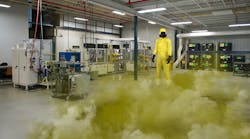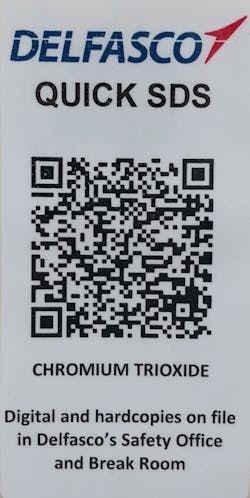During a chemical spill, every second counts. The first step in responding to a spill is to identify the substance and determine the hazards involved, so that the necessary precautions can be taken to protect personnel in the immediate area.
As safety professionals, our job is to get a Safety Data Sheet (SDS) into the hands of the person dealing with the spill by the fastest means possible. If a worker must look through a binder or log onto a computer, they may lose critical seconds. Meanwhile, the spill could be spreading.
Innovative use of commonly available QR code technology adapts particularly well to SDS applications. The square, black and white QR code works similarly to a bar code, but unlike a bar code, which brings up only a small amount of information, a QR code can bring up an entire document.
By creating QR code labels, we can enable workers to have the correct SDS in their hands in seconds. Workers are equipped with a phone app that is pointed at the code, scans it, and immediately brings up the SDS.
Creating customized QR code SDS labels is simple, cost-effective and requires only a minimal setup process to implement.
Upload .PDF Files
Each PDF will need to have a unique and publicly accessible URL. Ideally these PDF files should be hosted on the company website server so that they are not relocated by an outside entity. Enlist the assistance of your company’s webmaster or IT professional to upload these documents.
Design Container Tags or Labels
There are several important elements to keep in mind when designing your container labels. Keep the design simple and use bold, easily readable text. Include a company logo, a statement of purpose such as “Quick SDS,” the QR code, the name of the chemical, and the location where a backup copy of the SDS can be found. (see image below).
Download the App
A variety of QR code scanning applications are available to download for free on the Internet. These apps function with most brands of smartphones that are equipped with a camera. However, not all QR code scanner apps are created equally. Some require additional steps to operate or may include advertising that could interfere with the operation of the smart device. Try out several applications, then choose one and have all users download the same application. If your company has a policy against cellular phone use, consider if the purchase of a dedicated handheld scanner is more appropriate for your company.
Generate QR Codes
Once the PDF files have been uploaded onto the server, QR codes can be generated. A variety of online websites are available to generate QR codes at no cost. Enter the URL of the .PDF document and the website will generate a unique QR code to access it. Save the code image into your hard drive as a .JPG file.
Print Container Tags or Labels
Place the QR code image into the label design. Edit the chemical name on the label to match the SDS. Consider what the label might be exposed to during a spill and consider using laminated tags or waterproof printed labels. If paper labels are used, more than one label should be on the container in case a label is damaged.
Test and Review
Test each label to ensure that the QR code is working and properly accessing the correct SDS document. Review the chemical name to make certain that it is correct before affixing the tag or label to a chemical container.
Train Employees
Have employees download the app and train them on its use. Make sure they are comfortable using the app and answer any questions they may have about using it.
Implementing high-speed technology to access critical safety data during an emergency opens the door to a whole new realm of technological possibilities in environmental safety. However, technology is not the key to creating a safer workplace; people are. No technology can replace a strong culture of workplace safety, and technology is useless if the workers don’t understand or support it. Technology is, however, another new and very promising tool in our toolboxes, and one that can speed information into the hands of workers when they need it most.
Claire Britton-Black is the EHS manager at Delfasco LLC, a steel manufacturer for the U.S. Department of Defense in Afton, Tenn.

